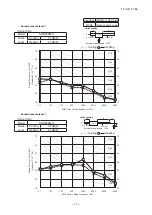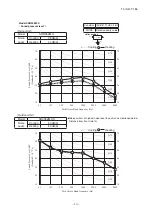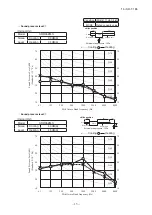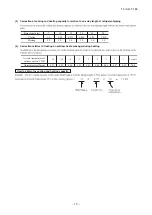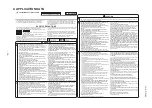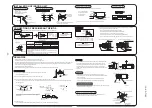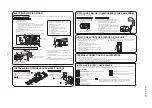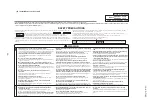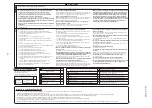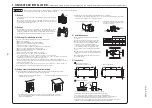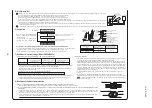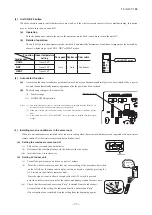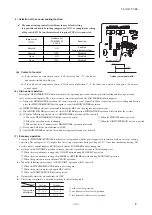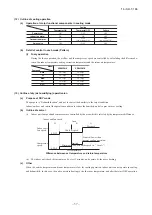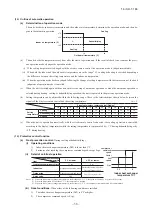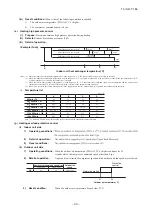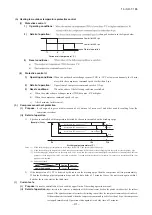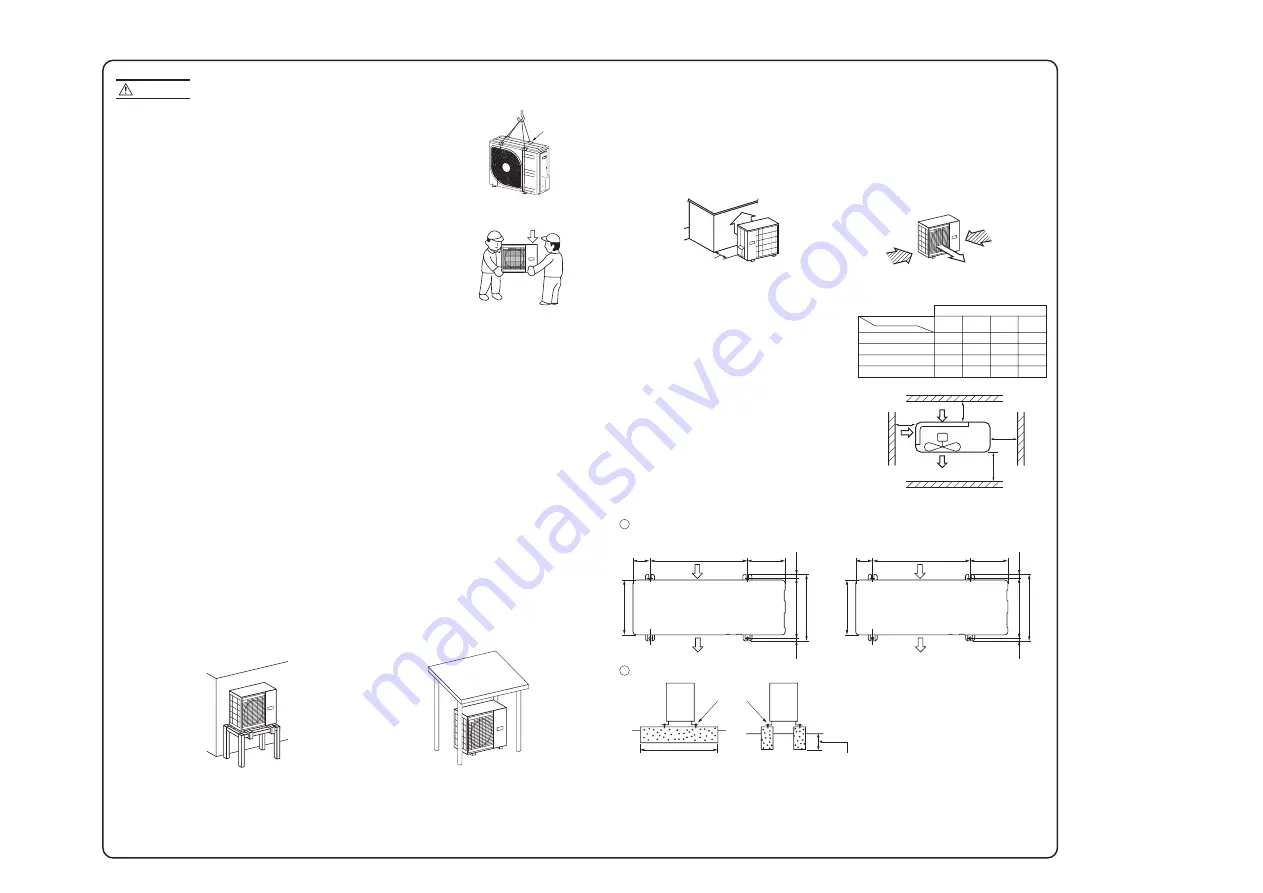
-
-
'15 • SR-T-185
INSTALLATION MANUAL FOR OUTDOOR UNIT
RWC012A044A
SRC20·25·35·50
Model DXC06·09·12·18
Accessories for outdoor unit
• Model name and power source
• Refrigerant piping length
• Piping, wiring and miscellaneous small parts
• Indoor unit installation manual
Necessary tools for the installation work
Wrench key (Hexagon) [4m/m]
Vacuum pump
Vacuum pump adapter (Anti-reverse flow type)
(Designed specifically for R410A)
Gauge manifold (Designed specifically for R410A)
Charge hose (Designed specifically for R410A)
Flaring tool set (Designed specifically for R410A)
Gas leak detector (Designed specifically for R410A)
Gauge for projection adjustment
(Used when flare is made by using conventional flare tool)
9
10
11
12
13
14
15
16
Plus headed driver
Knife
Saw
Tape measure
Hammer
Spanner wrench
Torque wrench [14.0
~
62.0N·m (1.4
~
6.2kgf·m)]
Hole core drill (65mm in diameter)
1
2
3
4
5
6
7
8
Grommet
(Heat pump
type only)
SRC20~35
Model
DXC06~12
Model SRC50/DXC18
Q’ty
1
4
1
Option parts
Sealing plate
Sleeve
Inclination plate
Putty
Drain hose (extension hose)
Piping cover
(for insulation of connection piping)
Q’ty
1
1
1
1
1
1
1
Drain elbow (Heat pump type only)
Check before installation work
a
b
c
d
e
f
2
R410A REFRIGERANT USED
1. HAULAGE AND INSTALLATION
(Take particular care in carrying in or moving the unit, and always perform such an operation with two or more persons.)
Intake
The height of a wall is 1200mm or less.
(
service
space
)
Intake
Outlet
Fasten with bolts
(M10-12)
Use a thicker block to anchor deeper.
Use a long block to extend the width.
CAUTION
When a unit is hoisted with slings for haulage, take into consideration the offset of its gravity center position.
If not properly balanced, the unit can be thrown off-balance and fall.
1) Delivery
2) Portage
3) Selecting the installation location
5) Installation space
L
3
L
2
L
4
L
1
Model SRC20~50/DXC06~18
Model SRC20~35/DXC06~12
Example installation
Size
L1
L2
L3
L4
Open
100
100
250
280
75
80
Open
280
Open
80
250
180
Open
80
Open
(mm)
I
II
III
IV
6) Installation
Pad
Over 500mm
Intake
Outlet
31
2.
5
24
.3
14
.8
29
0
111.6
510
158.4
35
1.
6
Model SRC50/DXC18
Intake
Outlet
31
2.
5
24
.3
14
.8
29
0
89
510
201
35
1.
6
• Deliver the unit as close as possible to the installation site before removing it from
the packaging.
• When you have to unpack the unit for a compelling reason before you haul it to
the installation point, hoist the unit with nylon slings or ropes and protection pads
so that you may not damage the unit.
• The right hand side of the unit as viewed from the front (diffuser side) is heavier.
A person carrying the right hand side must take heed of this fact. A person
carrying the left hand side must hold with his right hand the handle provided on
the front panel of the unit and with his left hand the corner column section.
(1) If the unit is installed in the area where the snow will accumulate, following measures are required.
The bottom plate of unit and intake, outlet may be blocked by snow.
1 Install the unit on the base so that the bottom is
higher than snow cover surface.
Since drain water generated by defrost control may freeze, following measures are required.
• Do not execute drain piping work by using a drain elbow and drain grommets (accessories).
[Refer to Drain piping work.]
Determine refrigerant pipe size pursuant to the following guidelines based on
the indoor unit specifications.
Without nitrogen gas, a large quantity of foreign matters
(oxidized film) are created, causing a critical failure from
capillary tube or expansion valve clogging.
2 Install the unit under or provide the roof on site.
Be careful of the following conditions and choose an installation place.
• Where air is not trapped.
• Where the installation fittings can be firmly installed.
• Where wind does not hinder the intake and outlet pipes.
• Out of the heat range of other heat sources.
• A place where stringent regulation of electric noises is not applicable.
• Where it is safe for the drain water to be discharged.
• Where noise and hot air will not bother neighboring residents.
• Where snow will not accumulate.
• Where strong winds will not blow against the outlet pipe.
• A place where no TV set or radio receiver is placed within 1m.
(If electrical interference is caused, seek a place less likely to cause the problem)
• If a operation is conducted when the outdoor air temperature is –5 C lower, the outdoor unit should be
installed at a place where it is not influenced by natural wind.
• Where it is likely that the unit is subjected to strong winds, provide wind guards according to the
following guidelines. Strong winds can cause performance degradation, an accidental stop due to a rise of
high pressure and a broken fan.
Do not install the unit in places which exposed to sea breeze (e.g. coastal area) or calcium chloride (e.g.
snow melting agent), exposed to ammonia substance (e.g. organic fertilizer).
2. REFRIGERANT PIPING WORK
1) Restrictions on unit installation and use
2) Determination of pipe size
15m or less
10m or less
10m or less
L
H
H
L
H
Outdoor unit
Indoor unit
The use restrictions appearing in the table above are applicable to the standard pipe size combinations shown in the table below.
Restrictions
Model SRC20~35/DXC06~12
Marks appearing in the
drawing on the right
Main pipe length
When the outdoor unit is positioned higher,
When the outdoor unit is positioned lower,
Elevation difference between
indoor and outdoor units
Plug the end of the pipe with tape, or other
material, and fill the pipe with nitrogen gas.
Only use nitrogen gas (N
2
)
Taping
<N2>
Ni
tro
ge
n
Brazing
Station valve
Primary side
Secondary side
0.5MPa
Hand
Relief valve
Nitrogen
gas
Brazing must be performed under a nitrogen gas flow.
About brazing
When pipe is brazing.
4) Caution about selection of installation location
• Walls surrounding the unit in the four sides are not
acceptable.
• There must be a 1-meter or larger space in the above.
• When more than one unit are installed side by side,
provide a 250mm or wider interval between them as a
service space. In order to facilitate servicing of
controllers, please provide a sufficient space between
units so that their top plates can be removed easily.
• Where a danger of short-circuiting exists, install guide
louvers.
• When more than one unit are installed, provide sufficient
intake space consciously so that short-circuiting may not
occur.
• Where piling snow can bury the outdoor unit, provide
proper snow guards.
• In installing the unit, fix the unit’s legs with bolts specified on the above.
• The protrusion of an anchor bolt on the front side must be kept within 15mm.
• Securely install the unit so that it does not fall over during earthquakes or strong winds, etc.
• Refer to the above illustrations for information regarding concrete foundations.
• Install the unit in a level area. (With a gradient of 5mm or less.) Improper installation can result in a
compressor failure, broken piping within the unit and abnormal noise generation.
1 Anchor bolt fixed position
2 Notabilia for installation
(2) If the unit can be affected by strong wind, following measures are required.
Strong wind can cause damage of fan (fan motor), or can cause performance degradation, or can trigger
anomalous stop of the unit due to rising of high pressure.
1 Place the unit outlet side is turned to the wall.
2 Install so the direction of the air from the
blowing outlet will be perpendicular to the
direction of the wind.
• Check the following points in light of the indoor unit specifications and the installation site.
• Observe the following restrictions on unit installation and use. Improper installation can result in a compressor failure or performance degradation.
• Additional refrigerant charge is not required at all (Model SRC20~35/DXC06~12).
25m or less
15m or less
15m or less
Dimensional restrictions
Model SRC50/DXC18
ø12.7
Flare
ø12.7
ø12.7
Gas pipe
ø6.35
Flare
ø6.35
ø6.35
Model SRC50/DXC18
Liquid pipe
ø9.52
Flare
ø9.52
ø9.52
Gas pipe
ø6.35
Flare
ø6.35
ø6.35
Model SRC20~35/DXC06~12
Liquid pipe
Outdoor unit connected
Refrigerant piping (branch pipe L)
Indoor unit connected
Notabilia as a unit designed for R410A
• Do not use any refrigerant other than R410A. R410A will rise to pressure about 1.6 times higher than that of a conventional refrigerant.
A cylinder containing R410A has a pink indication mark on the top.
• A unit designed for R410A has adopted a different size indoor unit servic valve charge port and a different size check joint provided in the unit to prevent the charging of a wrong refrigerant by mistake.
The processed dimension of the flared part of a refrigerant pipe and a flare nut’s parallel side measurement have also been altered to raise strength against pressure.
Accordingly, you are required to arrange dedicated R410A tools listed in the table on the left before installing or servicing this unit.
• Do not use a charge cylinder. The use of a charge cylinder will cause the refrigerant composition to change, which results in performance degradation.
• In charging refrigerant, always take it out from a cylinder in the liquid phase.
• All indoor units must be models designed exclusively for R410A. Check connectable indoor unit models in a catalog, etc. (A wrong indoor unit, if connected into the system, will impair proper system operation)
CAUTION
• Read the “SAFETY PRECAUTIONS” carefully first of all and strictly follow it during the installation work in order
to protect yourself.
• The precautionary items mentioned below are distinguished into two levels,
and
.
: Wrong installation would cause serious consequences such as injuries or death.
: Wrong installation might cause serious consequences depending on circumstances.
Both mentions the important items to protect your health and safety so strictly follow them by any means.
• Be sure to confirm no anomaly on the equipment by commissioning after completed installation and explain the
operating methods as well as the maintenance methods of this equipment to the user according to the owner’s
manual.
• Keep the installation manual together with owner’s manual at a place where any user can read at any time.
Moreover if necessary, ask to hand them to a new user.
• For installing qualified personnel, take precautions in respect to themselves by using suitable protective
clothing, groves, etc., and then perform the installation works.
• Please pay attention not to fall down the tools, etc. when installing the unit at the high position.
• If unusual noise can be heard during operation, consult the dealer.
• The meanings of “Marks” used here are shown as follows:
• This installation manual deals with outdoor units and general installation specifications only. For indoor units, refer to page 20.
• When install the unit, be sure to check whether the selection of installation place, power source specifications, usage limitation (piping length, height differences between indoor and outdoor units, power
source voltage and etc.) and installation spaces.
SAFETY PRECAUTIONS
WARNING
Never do it under any circumstances.
Always do it according to the instruction.
CAUTION
WARNING
CAUTION
WARNING
CAUTION
• Carry out the electrical work for ground lead with care.
Do not connect the ground lead to the gas line, water line, lightning conductor or telephone line’s ground lead. Incorrect grounding can cause unit faults such as electric shocks due to short-circuiting.
• Installation must be carried out by the qualified installer.
If you install the system by yourself, it may cause serious trouble such as water leaks,
electric shocks, fire and personal injury, as a result of a system malfunction. Do not
carry out the installation and maintenance work except the by qualified installer.
• Install the system in full accordance with the installation manual.
Incorrect installation may cause bursts, personal injury, water leaks, electric
shocks and fire.
• Be sure to use only for household and residence.
If this appliance is installed in inferior environment such as machine shop and etc.,
it can cause malfunction.
• When installing in small rooms, take prevention measures not to
exceed the density limit of refrigerant in the event of leakage, referred
by the formula (accordance with ISO5149).
If the density of refrigerant exceeds the limit, please consult the dealer and install
the ventilation system, otherwise lack of oxygen can occur, which can cause serious
accident.
• Use the original accessories and the specified components for
installation.
If parts other than those prescribed by us are used, It may cause water leaks,
electric shocks, fire and personal injury.
• Install the unit in a location with good support.
Unsuitable installation locations can cause the unit to fall and cause material
damage and personal injury.
• Ensure the unit is stable when installed, so that it can withstand
earthquakes and strong winds.
Unsuitable installation locations can cause the unit to fall and cause material
damage and personal injury.
• Ventilate the working area well in the event of refrigerant leakage during
installation.
If the refrigerant comes into contact with naked flames, poisonous gas is produced.
• Use the prescribed pipes, flare nuts and tools for R410A.
Using existing parts (for R22 or R407C) can cause the unit failure and serious
accidents due to burst of the refrigerant circuit.
• Tighten the flare nut by torque wrench with specified method.
If the flare nut were tightened with excess torque, this may cause burst and
refrigerant leakage after a long period.
• Do not open the service valves for liquid line and gas line until
completed refrigerant piping work, air tightness test and evacuation.
If the compressor is operated in state of opening service valves before completed
connection of refrigerant piping work, air can be sucked into refrigerant circuit,
which can cause bust or personal injury due to anomalously high pressure in the
refrigerant.
• The electrical installation must be carried out by the qualified electrician
in accordance with “the norm for electrical work” and “national wiring
regulation”, and the system must be connected to the dedicated circuit.
Power source with insufficient capacity and incorrect function done by improper
work can cause electric shocks and fire.
• Be sure to shut off the power before starting electrical work.
Failure to shut off the power can cause electric shocks, unit failure or incorrect
function of equipment.
• Be sure to use the cables conformed to safety standard and cable
ampacity for power distribution work.
Unconformable cables can cause electric leak, anomalous heat production or fire.
• This appliance must be connected to main power source by means of a
circuit breaker or switch (fuse:16A) with a contact separation of at least
3mm.
• Arrange the wiring in the control box so that it cannot be pushed up
further into the box. Install the service panel correctly.
Incorrect installation may result in overheating and fire.
• Use the prescribed cables for electrical connection, tighten the cables
securely in terminal block and relieve the cables correctly to prevent
overloading the terminal blocks.
Loose connections or cable mountings can cause anomalous heat production or fire.
• Be sure to fix up the service panels.
Incorrect fixing can cause electric shocks or fire due to intrusion of dust or water.
• Be sure to switch off the power source in the event of installation,
inspection or servicing.
If the power source is not shut off, there is a risk of electric shocks, unit failure or
personal injury due to the unexpected start of fan.
• Stop the compressor before removing the pipe after shutting the
operation valve on pump down work.
If the pipe is removed when the compressor is in operation with the service valve
open, air would be mixed in the refrigeration circuit and it could cause explosion
and injuries due to abnormal high pressure in the cooling cycle.
• Only use prescribed option parts. The installation must be carried out
by the qualified installer.
If you install the system by yourself, it can cause serious trouble such as water
leaks, electric shocks, fire.
• Be sure to wear protective goggles and gloves while at work.
• Earth leakage breaker must be installed.
If the earth leakage breaker is not installed, it can cause electric shocks.
• Ensure that no air enters in the refrigerant circuit when the unit is
installed and removed.
If air enters in the refrigerant circuit, the pressure in the refrigerant circuit
becomes too high, which can cause burst and personal injury.
• Do not processing, splice the power cord, or share a socket with other power plugs.
This may cause fire or electric shock due to defecting contact, defecting insulation
and over-current etc.
• Do not bundling, winding or processing for the power cable. Or, do not
deforming the power plug due to tread it.
This may cause fire or heating.
• Do not run the unit with removed panels or protections.
Touching rotating equipments, hot surfaces or high voltage parts can cause
personal injury due to entrapment, burn or electric shocks.
• Do not perform any change of protective device itself or its setup
condition.
The forced operation by short-circuiting protective device of pressure switch and
temperature controller or the use of non specified component can cause fire or
burst.
• Use the circuit breaker for all pole correct capacity. Circuit breaker
should be the one that disconnect all poles under over current.
Using the incorrect circuit breaker, it can cause the unit malfunction and fire.
• Install isolator or disconnect switch on the power source wiring in
accordance with the local codes and regulations.
The isolator should be locked in OFF state in accordance with EN60204-1.
• After maintenance, all wiring, wiring ties and the like, should be returned
to their original state and wiring route, and the necessary clearance from
all metal parts should be secured.
• Secure a space for installation, inspection and maintenance specified in
the manual.
Insufficient space can result in accident such as personal injury due to falling from
the installation place.
• Take care when carrying the unit by hand.
If the unit weights more than 20kg, it must be carried by two or more persons. Do
not carry by the plastic straps, always use the carry handle when carrying the unit
by hand. Use gloves to minimize the risk of cuts by the aluminum fins.
• Dispose of any packing materials correctly.
Any remaining packing materials can cause personal injury as it contains nails and
wood. And to avoid danger of suffocation, be sure to keep the plastic wrapper
away from children and to dispose after tear it up.
• Be sure to insulate the refrigerant pipes so as not to condense the
ambient air moisture on them.
Insufficient insulation can cause condensation, which can lead to moisture
damage on the ceiling, floor, furniture and any other valuables.
• When perform the air conditioner operation (cooling or drying operation)
in which ventilator is installed in the room. In this case, using the air
conditioner in parallel with the ventilator, there is the possibility that
drain water may backflow in accordance with the room lapse into the
negative pressure status. Therefore, set up the opening port such as
incorporate the air into the room that may appropriate to ventilation (For
example; Open the door a little). In addition, just as above, so set up the
opening port if the room lapse into negative pressure status due to
register of the wind for the high rise apartment etc.
• Do not install the unit in the locations listed below.
•Locations where carbon fiber, metal powder or any powder is floating.
•Locations where any substances that can affect the unit such as sulphide gas,
chloride gas, acid and alkaline can occur.
•Vehicles and ships.
•Locations where cosmetic or special sprays are often used.
•Locations with direct exposure of oil mist and steam such as kitchen and
machine plant.
•Locations where any machines which generate high frequency harmonics are
used.
•Locations with salty atmospheres such as coastlines.
•Locations with heavy snow (If installed, be sure to provide base flame and snow
hood mentioned in the manual).
•Locations where the unit is exposed to chimney smoke.
•Locations at high altitude (more than 1000m high).
•Locations with ammonic atmospheres (e.g. organic fertilizer).
•Locations with calcium chloride (e.g. snow melting agent).
•Locations where heat radiation from other heat source can affect the unit.
•Locations without good air circulation.
•Locations with any obstacles which can prevent inlet and outlet air of the unit.
•Locations where short circuit of air can occur (in case of multiple units
installation).
•Locations where strong air blows against the air outlet of outdoor unit.
•Locations where something located above the unit could fall.
It can cause remarkable decrease in performance, corrosion and damage of
components, malfunction and fire.
• Do not install the outdoor unit in the locations listed below.
•
Locations where discharged hot air or operating sound of the outdoor unit can
bother neighborhood.
•
Locations where outlet air of the outdoor unit blows directly to an animal or
plants. The outlet air can affect adversely to the plant etc.
•
Locations where vibration can be amplified and transmitted due to insufficient
strength of structure.
•
Locations where vibration and operation sound generated by the outdoor unit
can affect seriously (on the wall or at the place near bed room).
•
Locations where an equipment affected by high harmonics is placed (TV set or
radio receiver is placed within 1m).
•
Locations where drainage cannot run off safely.
It can affect surrounding environment and cause a claim.
• Do not install the unit near the location where leakage of combustible
gases can occur.
If leaked gases accumulate around the unit, it can cause fire.
• Do not install the unit where corrosive gas (such as sulfurous acid gas etc.)
or combustible gas (such as thinner and petroleum gases) can accumulate
or collect, or where volatile combustible substances are handled.
Corrosive gas can cause corrosion of heat exchanger, breakage of plastic parts
and etc. And combustible gas can cause fire.
• Do not install nor use the system close to the equipment that generates
electromagnetic fields or high frequency harmonics.
Equipment such as inverters, standby generators, medical high frequency
equipments and telecommunication equipments can affect the system, and cause
malfunctions and breakdowns. The system can also affect medical equipment and
telecommunication equipment, and obstruct its function or cause jamming.
•
Do not install the outdoor unit in a location where insects and small
animals can inhabit.
Insects and small animals can enter the electric parts and cause damage or fire.
Instruct the user to keep the surroundings clean.
•
Do not use the base flame for outdoor unit which is corroded or damaged
due to long periods of operation.
Using an old and damage base flame can cause the unit falling down and cause
personal injury.
•
Do not use any materials other than a fuse with the correct rating in the
location where fuses are to be used.
Connecting the circuit with copper wire or other metal thread can cause unit
failure and fire.
•
Do not touch any buttons with wet hands.
It can cause electric shocks.
•
Do not touch any refrigerant pipes with your hands when the system is in
operation.
During operation the refrigerant pipes become extremely hot or extremely cold
depending the operating condition, and it can cause burn injury or frost injury.
•
Do not touch the suction or aluminum fin on the outdoor unit.
This may cause injury.
•
Do not put anything on the outdoor unit and operating unit.
This may cause damage the objects or injury due to falling to the object.
•
Do not use the unit for special purposes such as storing foods, cooling
precision instruments and preservation of animals, plants or art.
•
Do not clean up the unit with water.
Over 500mm
Heavy
Wind
direction
Wind
direction


